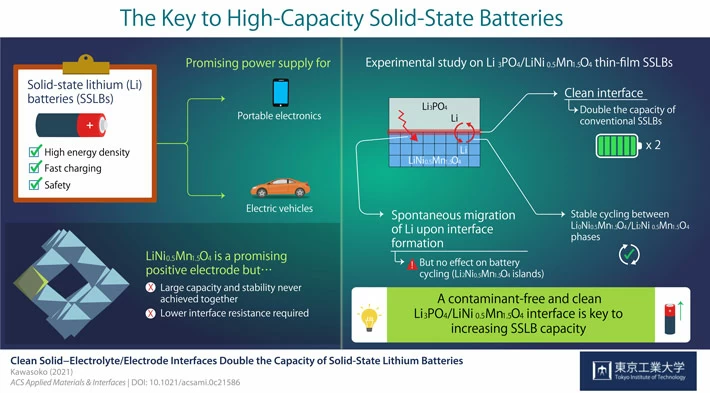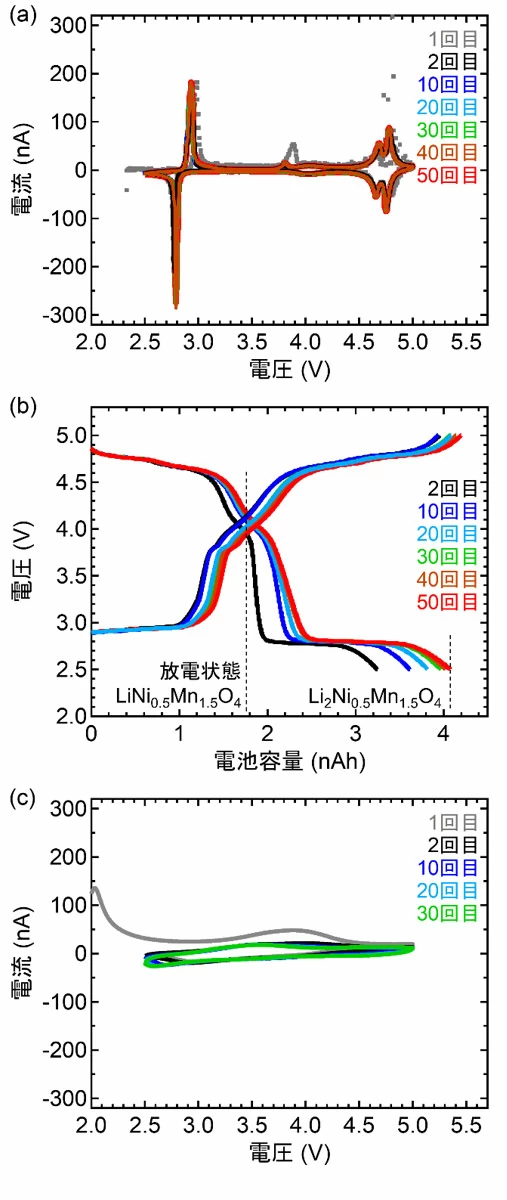

Tokyo Tech:将全固态电池的电池容量增加一倍:界面杂质控制
-增加电动汽车续航里程,扩大固定存储空间-
2021.01.26
要点:
发现创建干净的无杂质界面可使全固态电池的电池容量增加一倍
通过同步加速器辐射X射线衍射测量来澄清界面附近的锂分布和晶体状态。
概述:
东京工业大学材料科学与工程学院一杉教授
东北大学助理教授川田秀行
国立先进产业科学技术研究院高级研究员白泽
日本理工大学教授白木正
通过“控制电极和固体电解质形成的界面处的杂质”,我们成功地“使全固态电池的容量增加了一倍”。
将全固态电池的容量增加一倍:
全固态电池的发展目标包括增加电池容量和增加输出。
电池容量的增加导致设备可用时间的延长。
更高的输出功率使得可以在短时间内充电并立即取出大量电能。
双倍容量:
创建干净的电极/电解质界面,不含杂质
锂含量翻倍。
当Li“ 2” Ni0.5Mn1.5O4处于放电状态时,
锂为“ 0”的Ni0.5Mn1.5O4
我发现它可以使用。
换句话说,这意味着容量已加倍。
通过同步辐射X射线衍射测量验证:
此外,通过同步辐射X射线衍射测量证实,锂离子在界面形成过程中自发移动,并且Li 2 Ni 0.5 Mn 1.5 O 4在界面附近不均匀地存在。
这项研究不仅是朝着实现高容量全固态电池迈出的重要一步,而且还将导致在电极与固体电解质之间的界面处离子迁移理论的构建。
研究结果:
它于1月25日(美国东部时间)在线版发表在《美国化学学会杂志》的“ ACS应用材料和界面”上。
下一次部署:
这次,LiNi0.5Mn1.5O4全固态电池使电池容量增加了一倍。
强调了清洁电极/电解质界面的新作用。
到目前为止,通过制作干净的界面,
实现低界面阻力,
除了实现高速充放电
电池容量的这种加倍将导致全固态电池的应用范围扩大。
东京工业大学新闻|东京工业大学
https://www.titech.ac.jp/news/2021/048762.html
Keeping a Clean Path: Doubling the Capacity of Solid-State Lithium Batteries
Published: January 26, 2021
Scientists at Tokyo Institute of Technology (Tokyo Tech),
Tohoku University,
National Institute of Advanced Industrial Science and Technology, and
Nippon Institute of Technology,
demonstrated by experiment that
a clean electrolyte/electrode interface is key to realizing high-capacity solid-state lithium batteries.
Their findings
could pave the way for improved battery designs with increased capacity, stability, and safety for both mobile devices and electric vehicles.
solid-state lithium batteries (SSLBs)
SSLBs comprise solid electrodes and a solid electrolyte that exchange lithium (Li) ions during charging and discharging.
Their higher energy density and safety make SSLBs very powerful sources.
However, there are still many technical challenges preventing SSLBs’ commercialization.
For the current study, researchers conducted a series of experiments and gained insight that could take SSLBs’ performance to the next level.
the capacity of SSLBs
Strikingly, the clean interface facilitated the intercalation and deintercalation of Li during charging and discharging of the SSLBs.
As a result, the capacity of SSLBs with a clean interface was twice that of conventional LNMO-based batteries.
Moreover, this study marked the first time stable reversible reactions were found between the L0NMO and L2NMO phases in SSLBs.
Aside from mobile devices,
SSLBs could find a home in electric cars, for which cost and battery durability act as major barriers for widespread commercialization.
The results of this study
provide important insight for future SSLB designs and pave the way for a transition away from fossil fuels and towards more ecofriendly ways of transportation. Keep an eye out for the advent of SSLBs!
Tokyo Tech News | Tokyo Institute of Technology
https://www.titech.ac.jp/english/news/2021/048815.html
Clean Solid–Electrolyte/Electrode Interfaces Double the Capacity of Solid-State Lithium Batteries
Solid-state lithium (Li) batteries
using spinel-oxide electrode materials such as LiNi0.5Mn1.5O4
are promising power supplies for mobile devices and electric vehicles.
Here, we demonstrate stable battery cycling between the Li0Ni0.5Mn1.5O4 and Li2Ni0.5Mn1.5O4 phases with working voltages of approximately 2.9 and 4.7 V versus Li/Li+ in solid-state Li batteries with contamination-free clean Li3PO4/LiNi0.5Mn1.5O4 interfaces.
This clean interface
has the effect of doubling the capacity of conventional battery cycling between the Li0Ni0.5Mn1.5O4 and Li1Ni0.5Mn1.5O4 phases.
We also investigated the structural changes between the Li0Ni0.5Mn1.5O4 and Li2Ni0.5Mn1.5O4 phases during battery cycling.
ACS Applied Materials & Interfaces
https://pubs.acs.org/doi/10.1021/acsami.0c21586
什么是同步辐射X射线衍射?
http://hep-www.px.tsukuba.ac.jp/TCHoU/LDPPD/event/slide151130/nishibori.pdf